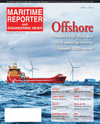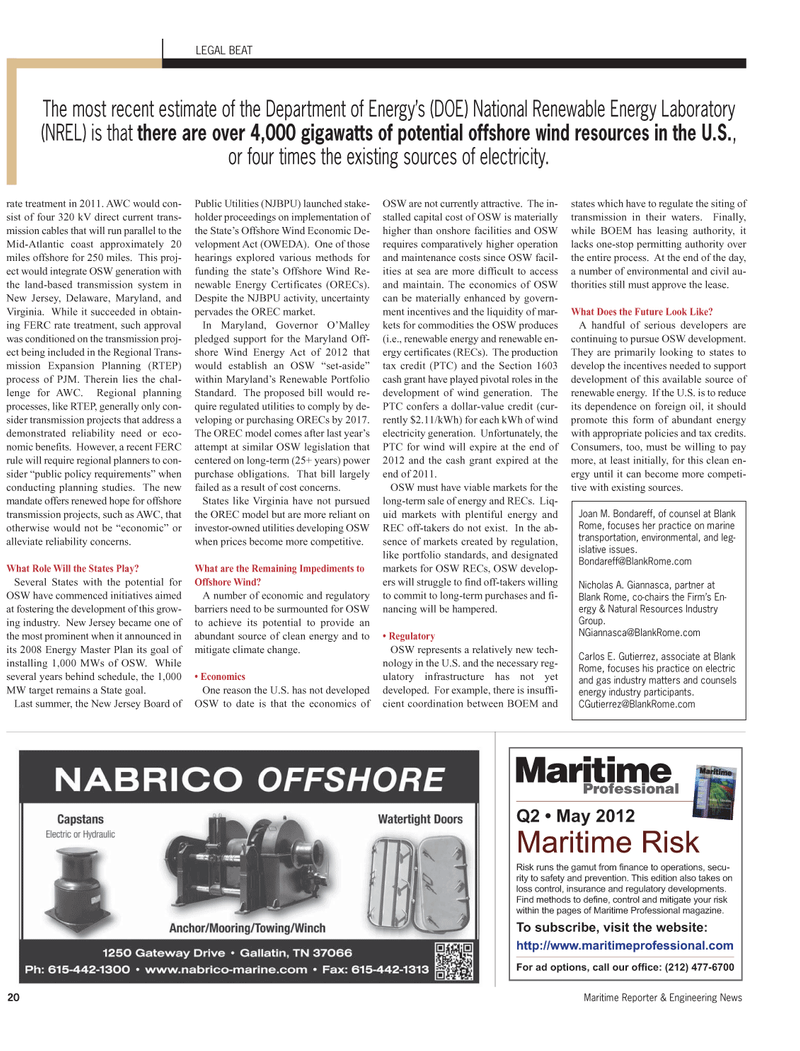
Page 20: of Maritime Reporter Magazine (April 2012)
Offshore Deepwater Annual
Read this page in Pdf, Flash or Html5 edition of April 2012 Maritime Reporter Magazine
Q2 ? May 2012 Maritime RiskRisk runs the gamut from finance to operations, secu-rity to safety and prevention. This edition also takes on loss control, insurance and regulatory developments.Find methods to define, control and mitigate your riskwithin the pages of Maritime Professional magazine.For ad options, call our office: (212) 477-6700To subscribe, visit the website: MaritimeProfessional http://www.maritimeprofessional.com rate treatment in 2011. AWC would con- sist of four 320 kV direct current trans-mission cables that will run parallel to theMid-Atlantic coast approximately 20miles offshore for 250 miles. This proj- ect would integrate OSW generation with the land-based transmission system inNew Jersey, Delaware, Maryland, and Virginia. While it succeeded in obtain- ing FERC rate treatment, such approval was conditioned on the transmission proj- ect being included in the Regional Trans- mission Expansion Planning (RTEP) process of PJM. Therein lies the chal- lenge for AWC. Regional planning processes, like RTEP, generally only con- sider transmission projects that address ademonstrated reliability need or eco-nomic benefits. However, a recent FERC rule will require regional planners to con- sider public policy requirements? when conducting planning studies. The new mandate offers renewed hope for offshore transmission projects, such as AWC, that otherwise would not be economic? or alleviate reliability concerns. What Role Will the States Play? Several States with the potential for OSW have commenced initiatives aimed at fostering the development of this grow- ing industry. New Jersey became one of the most prominent when it announced inits 2008 Energy Master Plan its goal of installing 1,000 MWs of OSW. While several years behind schedule, the 1,000 MW target remains a State goal. Last summer, the New Jersey Board of Public Utilities (NJBPU) launched stake- holder proceedings on implementation ofthe States Offshore Wind Economic De- velopment Act (OWEDA). One of those hearings explored various methods for funding the states Offshore Wind Re- newable Energy Certificates (ORECs). Despite the NJBPU activity, uncertainty pervades the OREC market. In Maryland, Governor OMalley pledged support for the Maryland Off- shore Wind Energy Act of 2012 that would establish an OSW set-aside? within Marylands Renewable Portfolio Standard. The proposed bill would re- quire regulated utilities to comply by de- veloping or purchasing ORECs by 2017. The OREC model comes after last years attempt at similar OSW legislation that centered on long-term (25+ years) power purchase obligations. That bill largely failed as a result of cost concerns. States like Virginia have not pursued the OREC model but are more reliant on investor-owned utilities developing OSW when prices become more competitive. What are the Remaining Impediments to Offshore Wind? A number of economic and regulatory barriers need to be surmounted for OSWto achieve its potential to provide an abundant source of clean energy and to mitigate climate change. ? EconomicsOne reason the U.S. has not developed OSW to date is that the economics ofOSW are not currently attractive. The in- stalled capital cost of OSW is materiallyhigher than onshore facilities and OSW requires comparatively higher operation and maintenance costs since OSW facil- ities at sea are more difficult to access and maintain. The economics of OSW can be materially enhanced by govern- ment incentives and the liquidity of mar- kets for commodities the OSW produces (i.e., renewable energy and renewable en- ergy certificates (RECs). The production tax credit (PTC) and the Section 1603cash grant have played pivotal roles in the development of wind generation. The PTC confers a dollar-value credit (cur- rently $2.11/kWh) for each kWh of windelectricity generation. Unfortunately, the PTC for wind will expire at the end of 2012 and the cash grant expired at the end of 2011. OSW must have viable markets for the long-term sale of energy and RECs. Liq- uid markets with plentiful energy and REC off-takers do not exist. In the ab- sence of markets created by regulation, like portfolio standards, and designated markets for OSW RECs, OSW develop- ers will struggle to find off-takers willing to commit to long-term purchases and fi- nancing will be hampered. ? RegulatoryOSW represents a relatively new tech- nology in the U.S. and the necessary reg- ulatory infrastructure has not yetdeveloped. For example, there is insuffi- cient coordination between BOEM andstates which have to regulate the siting of transmission in their waters. Finally, while BOEM has leasing authority, it lacks one-stop permitting authority over the entire process. At the end of the day, a number of environmental and civil au- thorities still must approve the lease. What Does the Future Look Like? A handful of serious developers are continuing to pursue OSW development. They are primarily looking to states to develop the incentives needed to support development of this available source of renewable energy. If the U.S. is to reduce its dependence on foreign oil, it shouldpromote this form of abundant energy with appropriate policies and tax credits. Consumers, too, must be willing to paymore, at least initially, for this clean en- ergy until it can become more competi- tive with existing sources. LEGAL BEAT Joan M. Bondareff, of counsel at Blank Rome, focuses her practice on marinetransportation, environmental, and leg- islative [email protected] Nicholas A. Giannasca, partner at Blank Rome, co-chairs the Firms En- ergy & Natural Resources Industry Group. [email protected] E. Gutierrez, associate at Blank Rome, focuses his practice on electricand gas industry matters and counselsenergy industry participants. [email protected] The most recent estimate of the Department of Energys (DOE) National Renewable Energy Laboratory (NREL) is that there are over 4,000 gigawatts of potential offshore wind resources in the U.S. ,or four times the existing sources of electricity. 20Maritime Reporter & Engineering News

 19
19

 21
21
